University Project: Managing Technology Changes and Sogeti's Team Park
VerifiedAdded on 2021/04/19
|11
|2315
|380
Report
AI Summary
This individual project analyzes the challenges faced by Sogeti in managing technology changes, specifically focusing on the Team Park project. The report identifies issues such as communication gaps, lack of employee motivation, and the absence of clear goals. It explores the causes of these problems, including failures in senior management's understanding of employee needs. The project assesses these issues and provides recommendations for improvement, including the application of the ISM Model, the Strategic Change Process Model, and the Goffee and Jones cultural change framework. The report emphasizes the importance of feedback, training, and employee involvement in decision-making to foster a more collaborative and productive work environment. Furthermore, the report discusses the anticipation of negative consequences and proposes workable principles for organizational change, such as consistent evaluation and the development of short-term goals. The project aims to provide a comprehensive analysis of the challenges and propose practical solutions for Sogeti to enhance teamwork, improve communication, and achieve its organizational objectives.
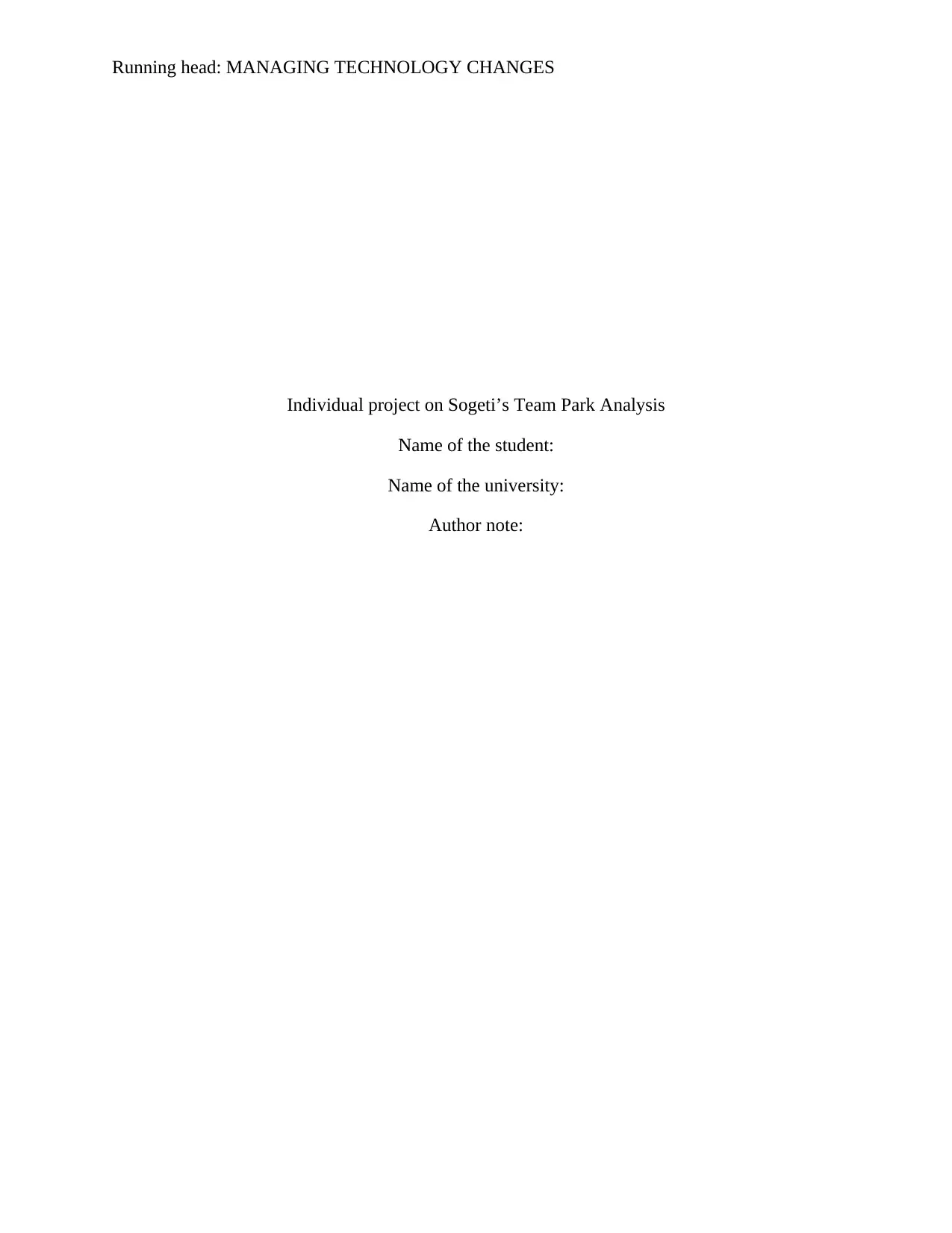
Running head: MANAGING TECHNOLOGY CHANGES
Individual project on Sogeti’s Team Park Analysis
Name of the student:
Name of the university:
Author note:
Individual project on Sogeti’s Team Park Analysis
Name of the student:
Name of the university:
Author note:
Paraphrase This Document
Need a fresh take? Get an instant paraphrase of this document with our AI Paraphraser
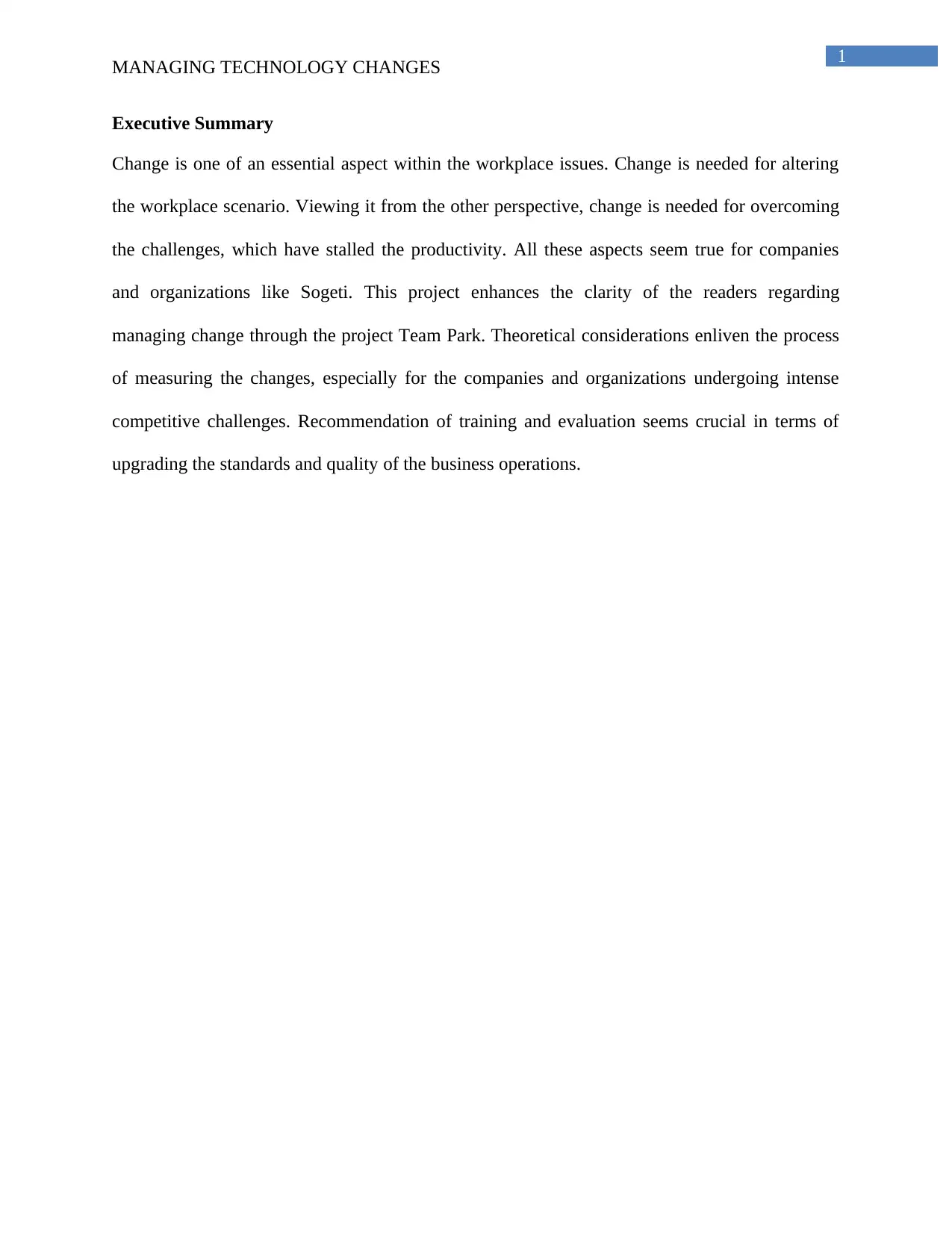
1
MANAGING TECHNOLOGY CHANGES
Executive Summary
Change is one of an essential aspect within the workplace issues. Change is needed for altering
the workplace scenario. Viewing it from the other perspective, change is needed for overcoming
the challenges, which have stalled the productivity. All these aspects seem true for companies
and organizations like Sogeti. This project enhances the clarity of the readers regarding
managing change through the project Team Park. Theoretical considerations enliven the process
of measuring the changes, especially for the companies and organizations undergoing intense
competitive challenges. Recommendation of training and evaluation seems crucial in terms of
upgrading the standards and quality of the business operations.
MANAGING TECHNOLOGY CHANGES
Executive Summary
Change is one of an essential aspect within the workplace issues. Change is needed for altering
the workplace scenario. Viewing it from the other perspective, change is needed for overcoming
the challenges, which have stalled the productivity. All these aspects seem true for companies
and organizations like Sogeti. This project enhances the clarity of the readers regarding
managing change through the project Team Park. Theoretical considerations enliven the process
of measuring the changes, especially for the companies and organizations undergoing intense
competitive challenges. Recommendation of training and evaluation seems crucial in terms of
upgrading the standards and quality of the business operations.
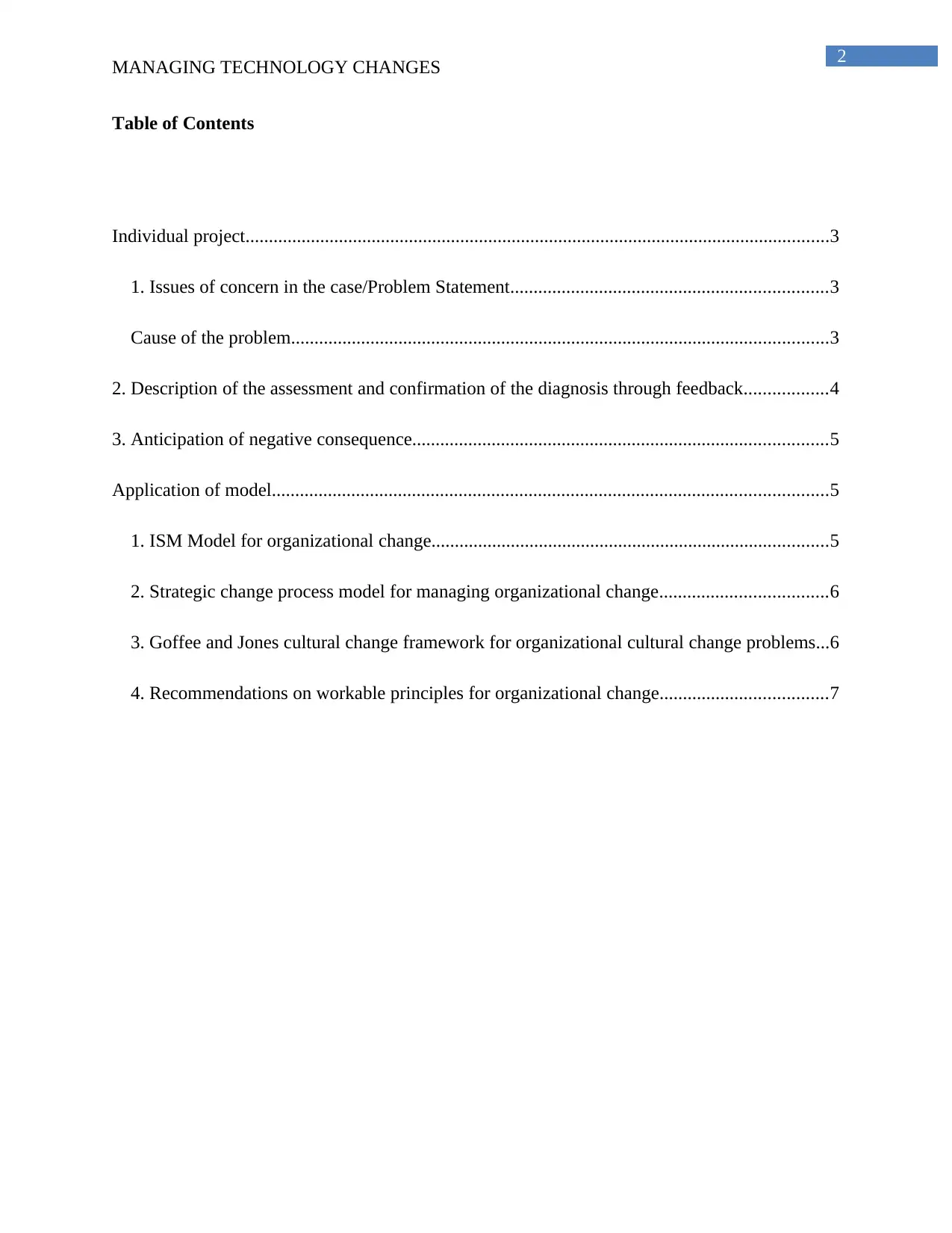
2
MANAGING TECHNOLOGY CHANGES
Table of Contents
Individual project.............................................................................................................................3
1. Issues of concern in the case/Problem Statement....................................................................3
Cause of the problem...................................................................................................................3
2. Description of the assessment and confirmation of the diagnosis through feedback..................4
3. Anticipation of negative consequence.........................................................................................5
Application of model.......................................................................................................................5
1. ISM Model for organizational change.....................................................................................5
2. Strategic change process model for managing organizational change....................................6
3. Goffee and Jones cultural change framework for organizational cultural change problems...6
4. Recommendations on workable principles for organizational change....................................7
MANAGING TECHNOLOGY CHANGES
Table of Contents
Individual project.............................................................................................................................3
1. Issues of concern in the case/Problem Statement....................................................................3
Cause of the problem...................................................................................................................3
2. Description of the assessment and confirmation of the diagnosis through feedback..................4
3. Anticipation of negative consequence.........................................................................................5
Application of model.......................................................................................................................5
1. ISM Model for organizational change.....................................................................................5
2. Strategic change process model for managing organizational change....................................6
3. Goffee and Jones cultural change framework for organizational cultural change problems...6
4. Recommendations on workable principles for organizational change....................................7
⊘ This is a preview!⊘
Do you want full access?
Subscribe today to unlock all pages.

Trusted by 1+ million students worldwide
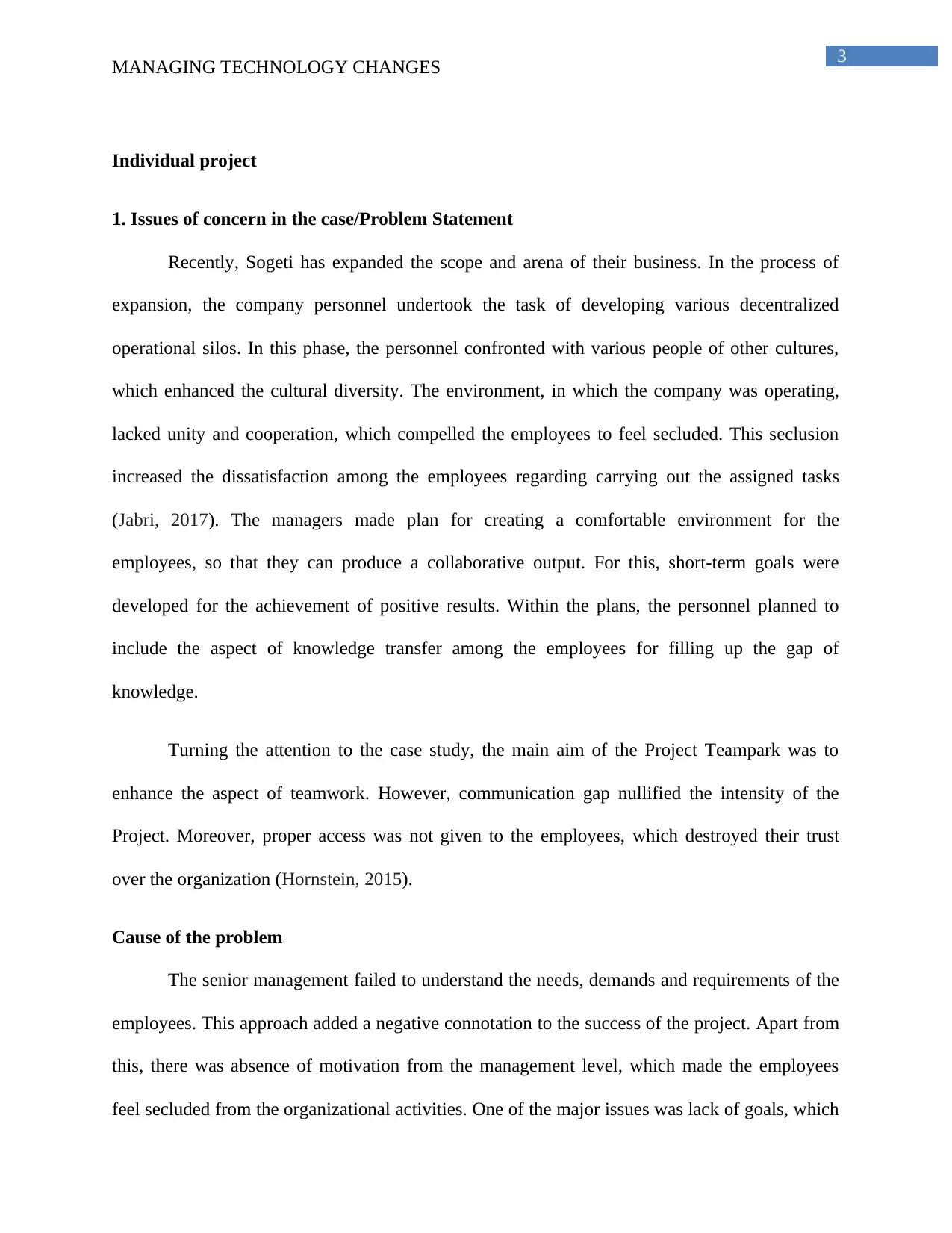
3
MANAGING TECHNOLOGY CHANGES
Individual project
1. Issues of concern in the case/Problem Statement
Recently, Sogeti has expanded the scope and arena of their business. In the process of
expansion, the company personnel undertook the task of developing various decentralized
operational silos. In this phase, the personnel confronted with various people of other cultures,
which enhanced the cultural diversity. The environment, in which the company was operating,
lacked unity and cooperation, which compelled the employees to feel secluded. This seclusion
increased the dissatisfaction among the employees regarding carrying out the assigned tasks
(Jabri, 2017). The managers made plan for creating a comfortable environment for the
employees, so that they can produce a collaborative output. For this, short-term goals were
developed for the achievement of positive results. Within the plans, the personnel planned to
include the aspect of knowledge transfer among the employees for filling up the gap of
knowledge.
Turning the attention to the case study, the main aim of the Project Teampark was to
enhance the aspect of teamwork. However, communication gap nullified the intensity of the
Project. Moreover, proper access was not given to the employees, which destroyed their trust
over the organization (Hornstein, 2015).
Cause of the problem
The senior management failed to understand the needs, demands and requirements of the
employees. This approach added a negative connotation to the success of the project. Apart from
this, there was absence of motivation from the management level, which made the employees
feel secluded from the organizational activities. One of the major issues was lack of goals, which
MANAGING TECHNOLOGY CHANGES
Individual project
1. Issues of concern in the case/Problem Statement
Recently, Sogeti has expanded the scope and arena of their business. In the process of
expansion, the company personnel undertook the task of developing various decentralized
operational silos. In this phase, the personnel confronted with various people of other cultures,
which enhanced the cultural diversity. The environment, in which the company was operating,
lacked unity and cooperation, which compelled the employees to feel secluded. This seclusion
increased the dissatisfaction among the employees regarding carrying out the assigned tasks
(Jabri, 2017). The managers made plan for creating a comfortable environment for the
employees, so that they can produce a collaborative output. For this, short-term goals were
developed for the achievement of positive results. Within the plans, the personnel planned to
include the aspect of knowledge transfer among the employees for filling up the gap of
knowledge.
Turning the attention to the case study, the main aim of the Project Teampark was to
enhance the aspect of teamwork. However, communication gap nullified the intensity of the
Project. Moreover, proper access was not given to the employees, which destroyed their trust
over the organization (Hornstein, 2015).
Cause of the problem
The senior management failed to understand the needs, demands and requirements of the
employees. This approach added a negative connotation to the success of the project. Apart from
this, there was absence of motivation from the management level, which made the employees
feel secluded from the organizational activities. One of the major issues was lack of goals, which
Paraphrase This Document
Need a fresh take? Get an instant paraphrase of this document with our AI Paraphraser
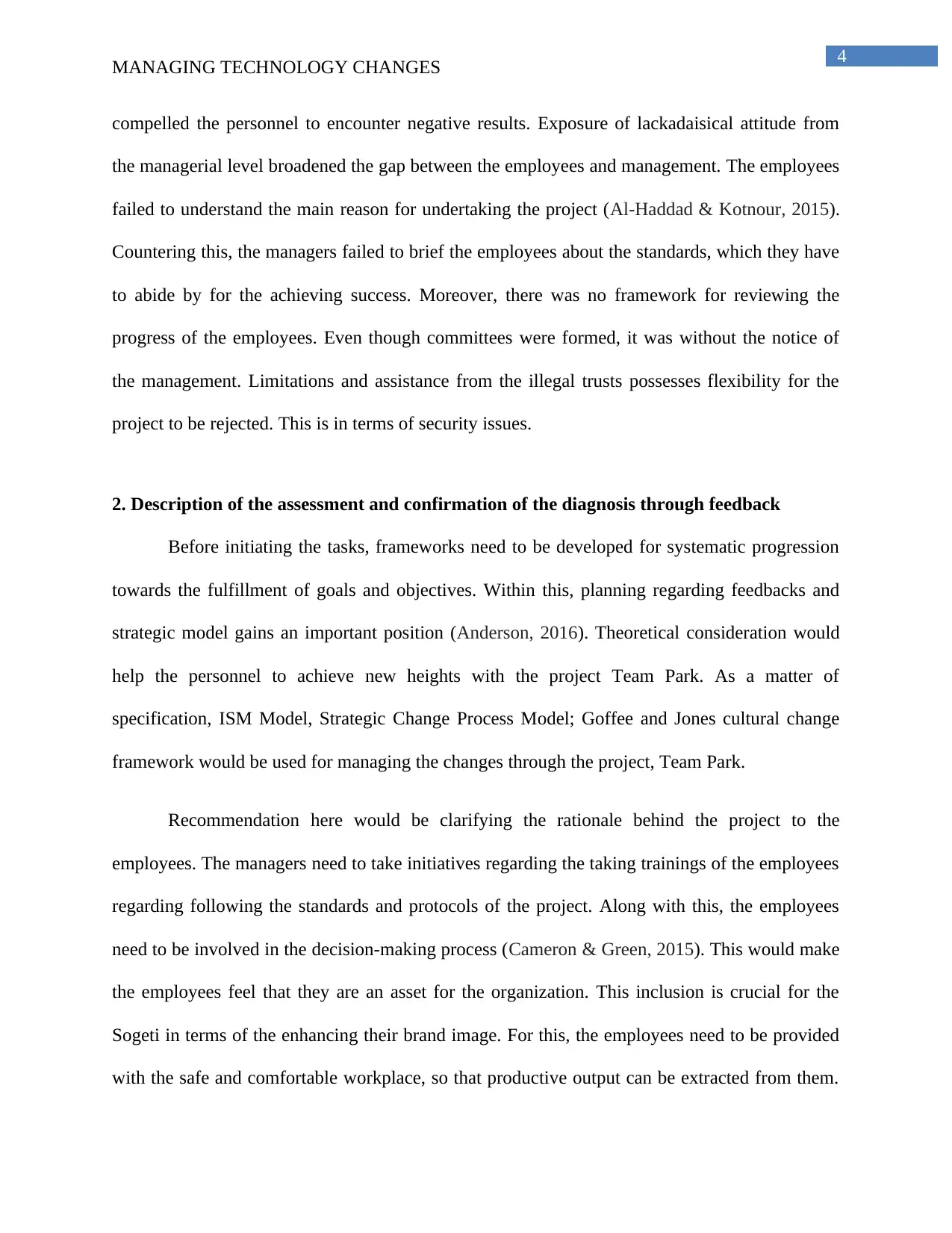
4
MANAGING TECHNOLOGY CHANGES
compelled the personnel to encounter negative results. Exposure of lackadaisical attitude from
the managerial level broadened the gap between the employees and management. The employees
failed to understand the main reason for undertaking the project (Al-Haddad & Kotnour, 2015).
Countering this, the managers failed to brief the employees about the standards, which they have
to abide by for the achieving success. Moreover, there was no framework for reviewing the
progress of the employees. Even though committees were formed, it was without the notice of
the management. Limitations and assistance from the illegal trusts possesses flexibility for the
project to be rejected. This is in terms of security issues.
2. Description of the assessment and confirmation of the diagnosis through feedback
Before initiating the tasks, frameworks need to be developed for systematic progression
towards the fulfillment of goals and objectives. Within this, planning regarding feedbacks and
strategic model gains an important position (Anderson, 2016). Theoretical consideration would
help the personnel to achieve new heights with the project Team Park. As a matter of
specification, ISM Model, Strategic Change Process Model; Goffee and Jones cultural change
framework would be used for managing the changes through the project, Team Park.
Recommendation here would be clarifying the rationale behind the project to the
employees. The managers need to take initiatives regarding the taking trainings of the employees
regarding following the standards and protocols of the project. Along with this, the employees
need to be involved in the decision-making process (Cameron & Green, 2015). This would make
the employees feel that they are an asset for the organization. This inclusion is crucial for the
Sogeti in terms of the enhancing their brand image. For this, the employees need to be provided
with the safe and comfortable workplace, so that productive output can be extracted from them.
MANAGING TECHNOLOGY CHANGES
compelled the personnel to encounter negative results. Exposure of lackadaisical attitude from
the managerial level broadened the gap between the employees and management. The employees
failed to understand the main reason for undertaking the project (Al-Haddad & Kotnour, 2015).
Countering this, the managers failed to brief the employees about the standards, which they have
to abide by for the achieving success. Moreover, there was no framework for reviewing the
progress of the employees. Even though committees were formed, it was without the notice of
the management. Limitations and assistance from the illegal trusts possesses flexibility for the
project to be rejected. This is in terms of security issues.
2. Description of the assessment and confirmation of the diagnosis through feedback
Before initiating the tasks, frameworks need to be developed for systematic progression
towards the fulfillment of goals and objectives. Within this, planning regarding feedbacks and
strategic model gains an important position (Anderson, 2016). Theoretical consideration would
help the personnel to achieve new heights with the project Team Park. As a matter of
specification, ISM Model, Strategic Change Process Model; Goffee and Jones cultural change
framework would be used for managing the changes through the project, Team Park.
Recommendation here would be clarifying the rationale behind the project to the
employees. The managers need to take initiatives regarding the taking trainings of the employees
regarding following the standards and protocols of the project. Along with this, the employees
need to be involved in the decision-making process (Cameron & Green, 2015). This would make
the employees feel that they are an asset for the organization. This inclusion is crucial for the
Sogeti in terms of the enhancing their brand image. For this, the employees need to be provided
with the safe and comfortable workplace, so that productive output can be extracted from them.
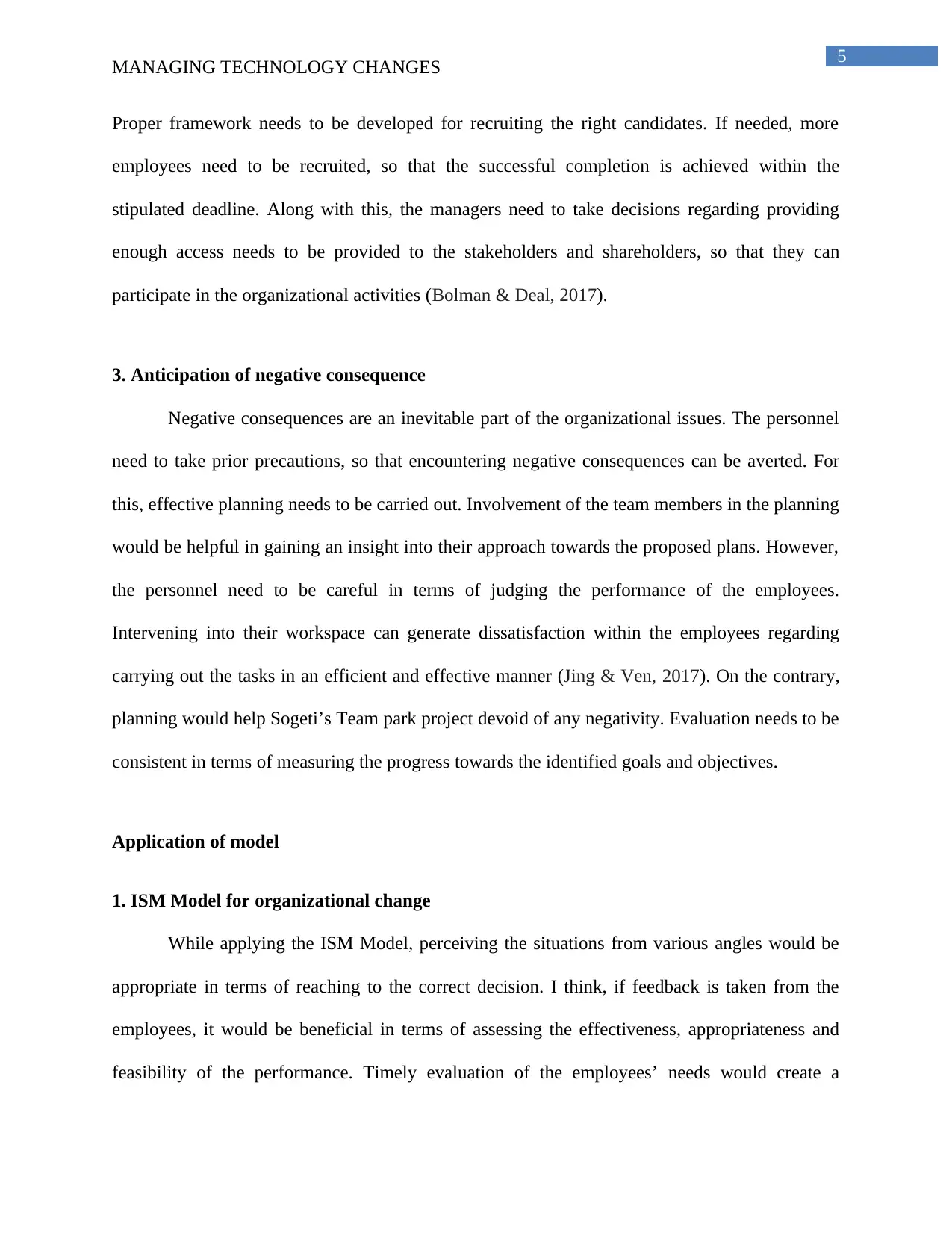
5
MANAGING TECHNOLOGY CHANGES
Proper framework needs to be developed for recruiting the right candidates. If needed, more
employees need to be recruited, so that the successful completion is achieved within the
stipulated deadline. Along with this, the managers need to take decisions regarding providing
enough access needs to be provided to the stakeholders and shareholders, so that they can
participate in the organizational activities (Bolman & Deal, 2017).
3. Anticipation of negative consequence
Negative consequences are an inevitable part of the organizational issues. The personnel
need to take prior precautions, so that encountering negative consequences can be averted. For
this, effective planning needs to be carried out. Involvement of the team members in the planning
would be helpful in gaining an insight into their approach towards the proposed plans. However,
the personnel need to be careful in terms of judging the performance of the employees.
Intervening into their workspace can generate dissatisfaction within the employees regarding
carrying out the tasks in an efficient and effective manner (Jing & Ven, 2017). On the contrary,
planning would help Sogeti’s Team park project devoid of any negativity. Evaluation needs to be
consistent in terms of measuring the progress towards the identified goals and objectives.
Application of model
1. ISM Model for organizational change
While applying the ISM Model, perceiving the situations from various angles would be
appropriate in terms of reaching to the correct decision. I think, if feedback is taken from the
employees, it would be beneficial in terms of assessing the effectiveness, appropriateness and
feasibility of the performance. Timely evaluation of the employees’ needs would create a
MANAGING TECHNOLOGY CHANGES
Proper framework needs to be developed for recruiting the right candidates. If needed, more
employees need to be recruited, so that the successful completion is achieved within the
stipulated deadline. Along with this, the managers need to take decisions regarding providing
enough access needs to be provided to the stakeholders and shareholders, so that they can
participate in the organizational activities (Bolman & Deal, 2017).
3. Anticipation of negative consequence
Negative consequences are an inevitable part of the organizational issues. The personnel
need to take prior precautions, so that encountering negative consequences can be averted. For
this, effective planning needs to be carried out. Involvement of the team members in the planning
would be helpful in gaining an insight into their approach towards the proposed plans. However,
the personnel need to be careful in terms of judging the performance of the employees.
Intervening into their workspace can generate dissatisfaction within the employees regarding
carrying out the tasks in an efficient and effective manner (Jing & Ven, 2017). On the contrary,
planning would help Sogeti’s Team park project devoid of any negativity. Evaluation needs to be
consistent in terms of measuring the progress towards the identified goals and objectives.
Application of model
1. ISM Model for organizational change
While applying the ISM Model, perceiving the situations from various angles would be
appropriate in terms of reaching to the correct decision. I think, if feedback is taken from the
employees, it would be beneficial in terms of assessing the effectiveness, appropriateness and
feasibility of the performance. Timely evaluation of the employees’ needs would create a
⊘ This is a preview!⊘
Do you want full access?
Subscribe today to unlock all pages.

Trusted by 1+ million students worldwide
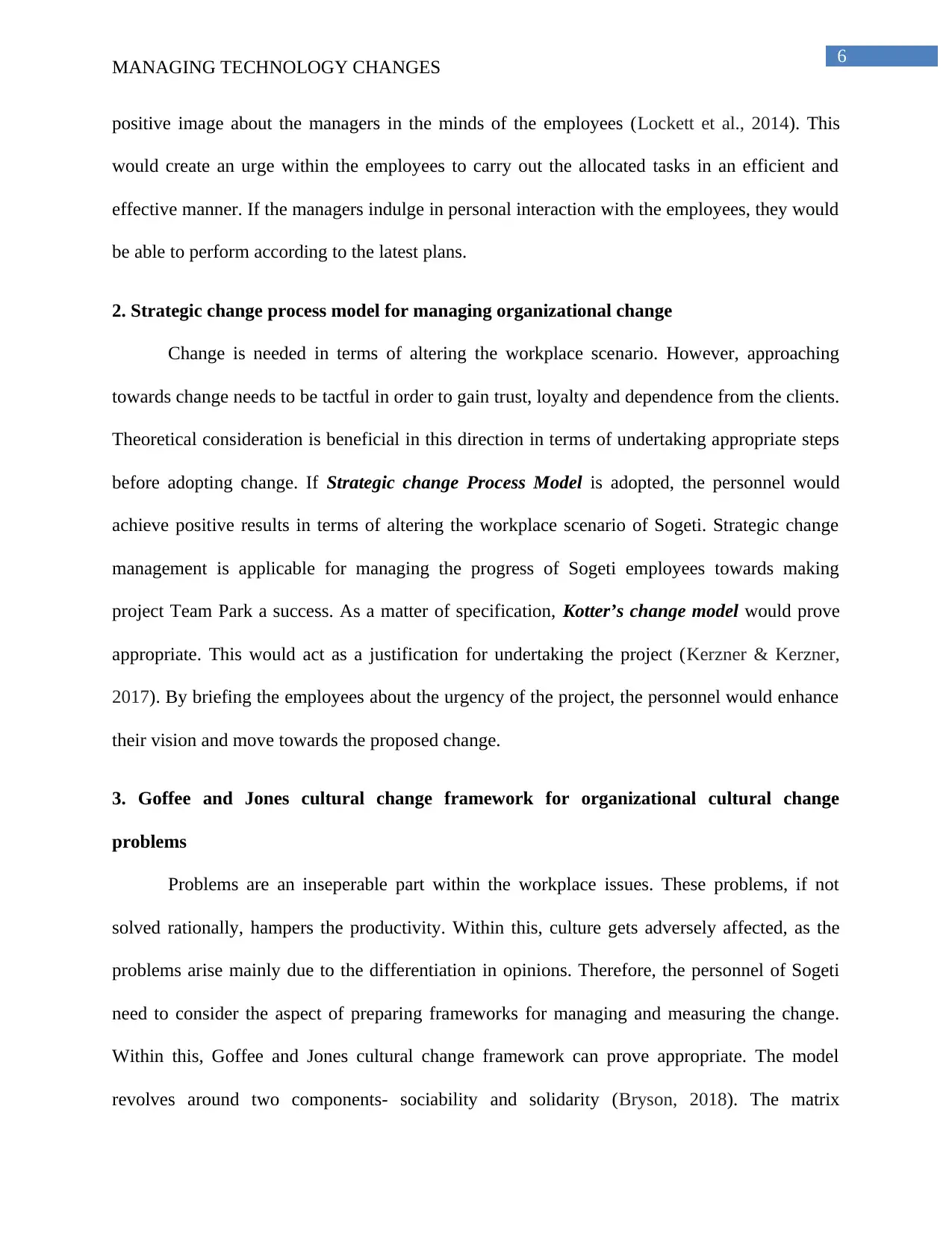
6
MANAGING TECHNOLOGY CHANGES
positive image about the managers in the minds of the employees (Lockett et al., 2014). This
would create an urge within the employees to carry out the allocated tasks in an efficient and
effective manner. If the managers indulge in personal interaction with the employees, they would
be able to perform according to the latest plans.
2. Strategic change process model for managing organizational change
Change is needed in terms of altering the workplace scenario. However, approaching
towards change needs to be tactful in order to gain trust, loyalty and dependence from the clients.
Theoretical consideration is beneficial in this direction in terms of undertaking appropriate steps
before adopting change. If Strategic change Process Model is adopted, the personnel would
achieve positive results in terms of altering the workplace scenario of Sogeti. Strategic change
management is applicable for managing the progress of Sogeti employees towards making
project Team Park a success. As a matter of specification, Kotter’s change model would prove
appropriate. This would act as a justification for undertaking the project (Kerzner & Kerzner,
2017). By briefing the employees about the urgency of the project, the personnel would enhance
their vision and move towards the proposed change.
3. Goffee and Jones cultural change framework for organizational cultural change
problems
Problems are an inseperable part within the workplace issues. These problems, if not
solved rationally, hampers the productivity. Within this, culture gets adversely affected, as the
problems arise mainly due to the differentiation in opinions. Therefore, the personnel of Sogeti
need to consider the aspect of preparing frameworks for managing and measuring the change.
Within this, Goffee and Jones cultural change framework can prove appropriate. The model
revolves around two components- sociability and solidarity (Bryson, 2018). The matrix
MANAGING TECHNOLOGY CHANGES
positive image about the managers in the minds of the employees (Lockett et al., 2014). This
would create an urge within the employees to carry out the allocated tasks in an efficient and
effective manner. If the managers indulge in personal interaction with the employees, they would
be able to perform according to the latest plans.
2. Strategic change process model for managing organizational change
Change is needed in terms of altering the workplace scenario. However, approaching
towards change needs to be tactful in order to gain trust, loyalty and dependence from the clients.
Theoretical consideration is beneficial in this direction in terms of undertaking appropriate steps
before adopting change. If Strategic change Process Model is adopted, the personnel would
achieve positive results in terms of altering the workplace scenario of Sogeti. Strategic change
management is applicable for managing the progress of Sogeti employees towards making
project Team Park a success. As a matter of specification, Kotter’s change model would prove
appropriate. This would act as a justification for undertaking the project (Kerzner & Kerzner,
2017). By briefing the employees about the urgency of the project, the personnel would enhance
their vision and move towards the proposed change.
3. Goffee and Jones cultural change framework for organizational cultural change
problems
Problems are an inseperable part within the workplace issues. These problems, if not
solved rationally, hampers the productivity. Within this, culture gets adversely affected, as the
problems arise mainly due to the differentiation in opinions. Therefore, the personnel of Sogeti
need to consider the aspect of preparing frameworks for managing and measuring the change.
Within this, Goffee and Jones cultural change framework can prove appropriate. The model
revolves around two components- sociability and solidarity (Bryson, 2018). The matrix
Paraphrase This Document
Need a fresh take? Get an instant paraphrase of this document with our AI Paraphraser
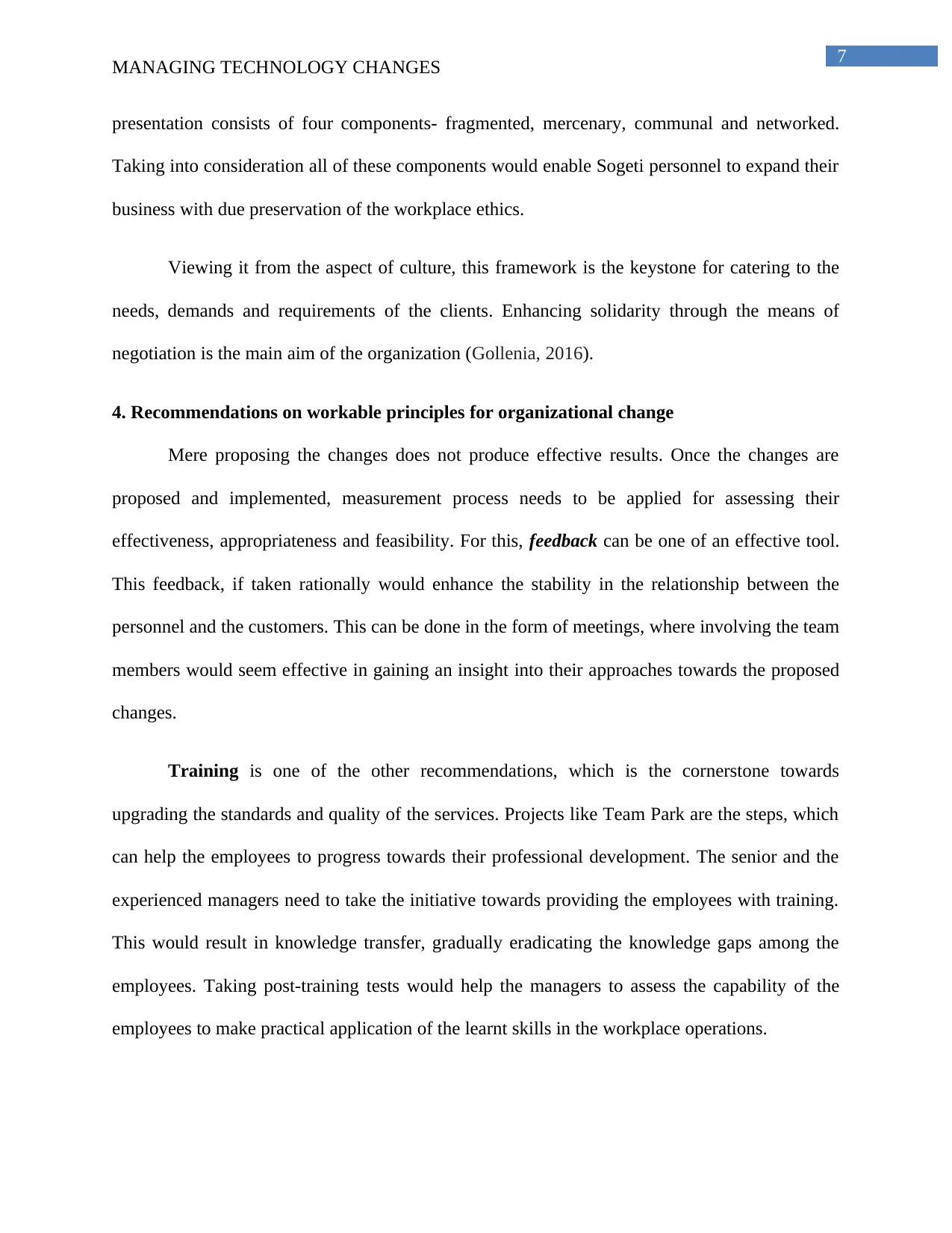
7
MANAGING TECHNOLOGY CHANGES
presentation consists of four components- fragmented, mercenary, communal and networked.
Taking into consideration all of these components would enable Sogeti personnel to expand their
business with due preservation of the workplace ethics.
Viewing it from the aspect of culture, this framework is the keystone for catering to the
needs, demands and requirements of the clients. Enhancing solidarity through the means of
negotiation is the main aim of the organization (Gollenia, 2016).
4. Recommendations on workable principles for organizational change
Mere proposing the changes does not produce effective results. Once the changes are
proposed and implemented, measurement process needs to be applied for assessing their
effectiveness, appropriateness and feasibility. For this, feedback can be one of an effective tool.
This feedback, if taken rationally would enhance the stability in the relationship between the
personnel and the customers. This can be done in the form of meetings, where involving the team
members would seem effective in gaining an insight into their approaches towards the proposed
changes.
Training is one of the other recommendations, which is the cornerstone towards
upgrading the standards and quality of the services. Projects like Team Park are the steps, which
can help the employees to progress towards their professional development. The senior and the
experienced managers need to take the initiative towards providing the employees with training.
This would result in knowledge transfer, gradually eradicating the knowledge gaps among the
employees. Taking post-training tests would help the managers to assess the capability of the
employees to make practical application of the learnt skills in the workplace operations.
MANAGING TECHNOLOGY CHANGES
presentation consists of four components- fragmented, mercenary, communal and networked.
Taking into consideration all of these components would enable Sogeti personnel to expand their
business with due preservation of the workplace ethics.
Viewing it from the aspect of culture, this framework is the keystone for catering to the
needs, demands and requirements of the clients. Enhancing solidarity through the means of
negotiation is the main aim of the organization (Gollenia, 2016).
4. Recommendations on workable principles for organizational change
Mere proposing the changes does not produce effective results. Once the changes are
proposed and implemented, measurement process needs to be applied for assessing their
effectiveness, appropriateness and feasibility. For this, feedback can be one of an effective tool.
This feedback, if taken rationally would enhance the stability in the relationship between the
personnel and the customers. This can be done in the form of meetings, where involving the team
members would seem effective in gaining an insight into their approaches towards the proposed
changes.
Training is one of the other recommendations, which is the cornerstone towards
upgrading the standards and quality of the services. Projects like Team Park are the steps, which
can help the employees to progress towards their professional development. The senior and the
experienced managers need to take the initiative towards providing the employees with training.
This would result in knowledge transfer, gradually eradicating the knowledge gaps among the
employees. Taking post-training tests would help the managers to assess the capability of the
employees to make practical application of the learnt skills in the workplace operations.
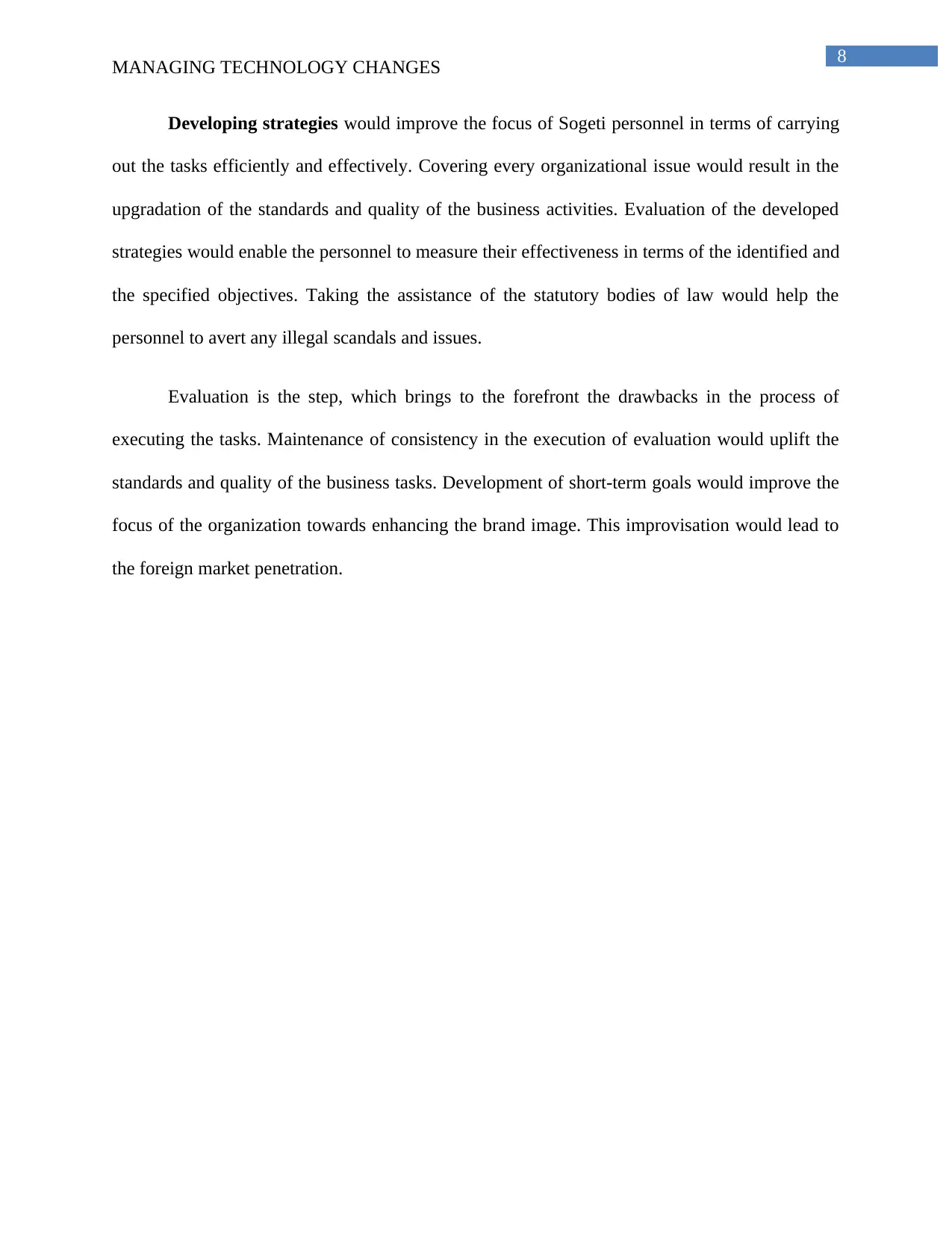
8
MANAGING TECHNOLOGY CHANGES
Developing strategies would improve the focus of Sogeti personnel in terms of carrying
out the tasks efficiently and effectively. Covering every organizational issue would result in the
upgradation of the standards and quality of the business activities. Evaluation of the developed
strategies would enable the personnel to measure their effectiveness in terms of the identified and
the specified objectives. Taking the assistance of the statutory bodies of law would help the
personnel to avert any illegal scandals and issues.
Evaluation is the step, which brings to the forefront the drawbacks in the process of
executing the tasks. Maintenance of consistency in the execution of evaluation would uplift the
standards and quality of the business tasks. Development of short-term goals would improve the
focus of the organization towards enhancing the brand image. This improvisation would lead to
the foreign market penetration.
MANAGING TECHNOLOGY CHANGES
Developing strategies would improve the focus of Sogeti personnel in terms of carrying
out the tasks efficiently and effectively. Covering every organizational issue would result in the
upgradation of the standards and quality of the business activities. Evaluation of the developed
strategies would enable the personnel to measure their effectiveness in terms of the identified and
the specified objectives. Taking the assistance of the statutory bodies of law would help the
personnel to avert any illegal scandals and issues.
Evaluation is the step, which brings to the forefront the drawbacks in the process of
executing the tasks. Maintenance of consistency in the execution of evaluation would uplift the
standards and quality of the business tasks. Development of short-term goals would improve the
focus of the organization towards enhancing the brand image. This improvisation would lead to
the foreign market penetration.
⊘ This is a preview!⊘
Do you want full access?
Subscribe today to unlock all pages.

Trusted by 1+ million students worldwide
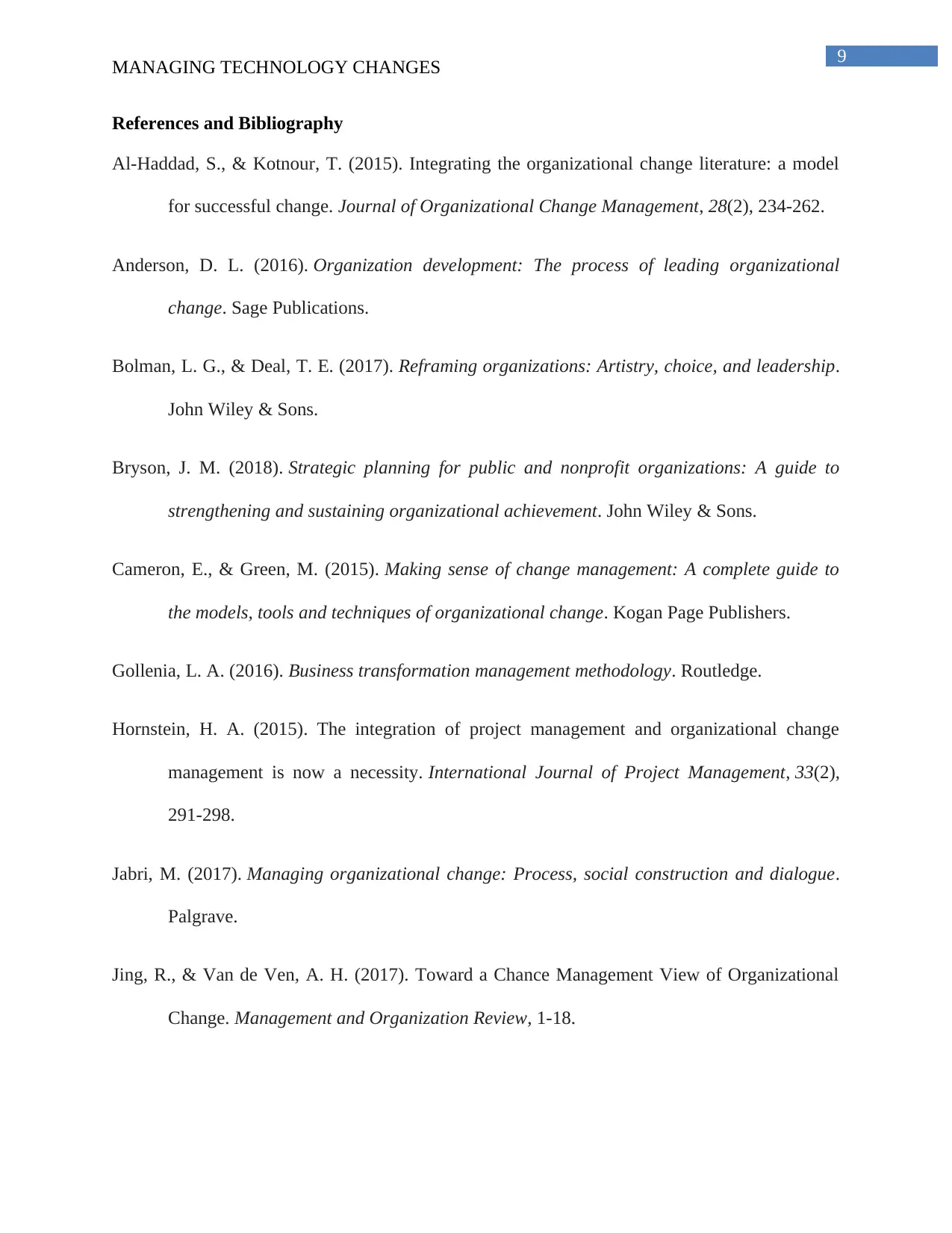
9
MANAGING TECHNOLOGY CHANGES
References and Bibliography
Al-Haddad, S., & Kotnour, T. (2015). Integrating the organizational change literature: a model
for successful change. Journal of Organizational Change Management, 28(2), 234-262.
Anderson, D. L. (2016). Organization development: The process of leading organizational
change. Sage Publications.
Bolman, L. G., & Deal, T. E. (2017). Reframing organizations: Artistry, choice, and leadership.
John Wiley & Sons.
Bryson, J. M. (2018). Strategic planning for public and nonprofit organizations: A guide to
strengthening and sustaining organizational achievement. John Wiley & Sons.
Cameron, E., & Green, M. (2015). Making sense of change management: A complete guide to
the models, tools and techniques of organizational change. Kogan Page Publishers.
Gollenia, L. A. (2016). Business transformation management methodology. Routledge.
Hornstein, H. A. (2015). The integration of project management and organizational change
management is now a necessity. International Journal of Project Management, 33(2),
291-298.
Jabri, M. (2017). Managing organizational change: Process, social construction and dialogue.
Palgrave.
Jing, R., & Van de Ven, A. H. (2017). Toward a Chance Management View of Organizational
Change. Management and Organization Review, 1-18.
MANAGING TECHNOLOGY CHANGES
References and Bibliography
Al-Haddad, S., & Kotnour, T. (2015). Integrating the organizational change literature: a model
for successful change. Journal of Organizational Change Management, 28(2), 234-262.
Anderson, D. L. (2016). Organization development: The process of leading organizational
change. Sage Publications.
Bolman, L. G., & Deal, T. E. (2017). Reframing organizations: Artistry, choice, and leadership.
John Wiley & Sons.
Bryson, J. M. (2018). Strategic planning for public and nonprofit organizations: A guide to
strengthening and sustaining organizational achievement. John Wiley & Sons.
Cameron, E., & Green, M. (2015). Making sense of change management: A complete guide to
the models, tools and techniques of organizational change. Kogan Page Publishers.
Gollenia, L. A. (2016). Business transformation management methodology. Routledge.
Hornstein, H. A. (2015). The integration of project management and organizational change
management is now a necessity. International Journal of Project Management, 33(2),
291-298.
Jabri, M. (2017). Managing organizational change: Process, social construction and dialogue.
Palgrave.
Jing, R., & Van de Ven, A. H. (2017). Toward a Chance Management View of Organizational
Change. Management and Organization Review, 1-18.
Paraphrase This Document
Need a fresh take? Get an instant paraphrase of this document with our AI Paraphraser
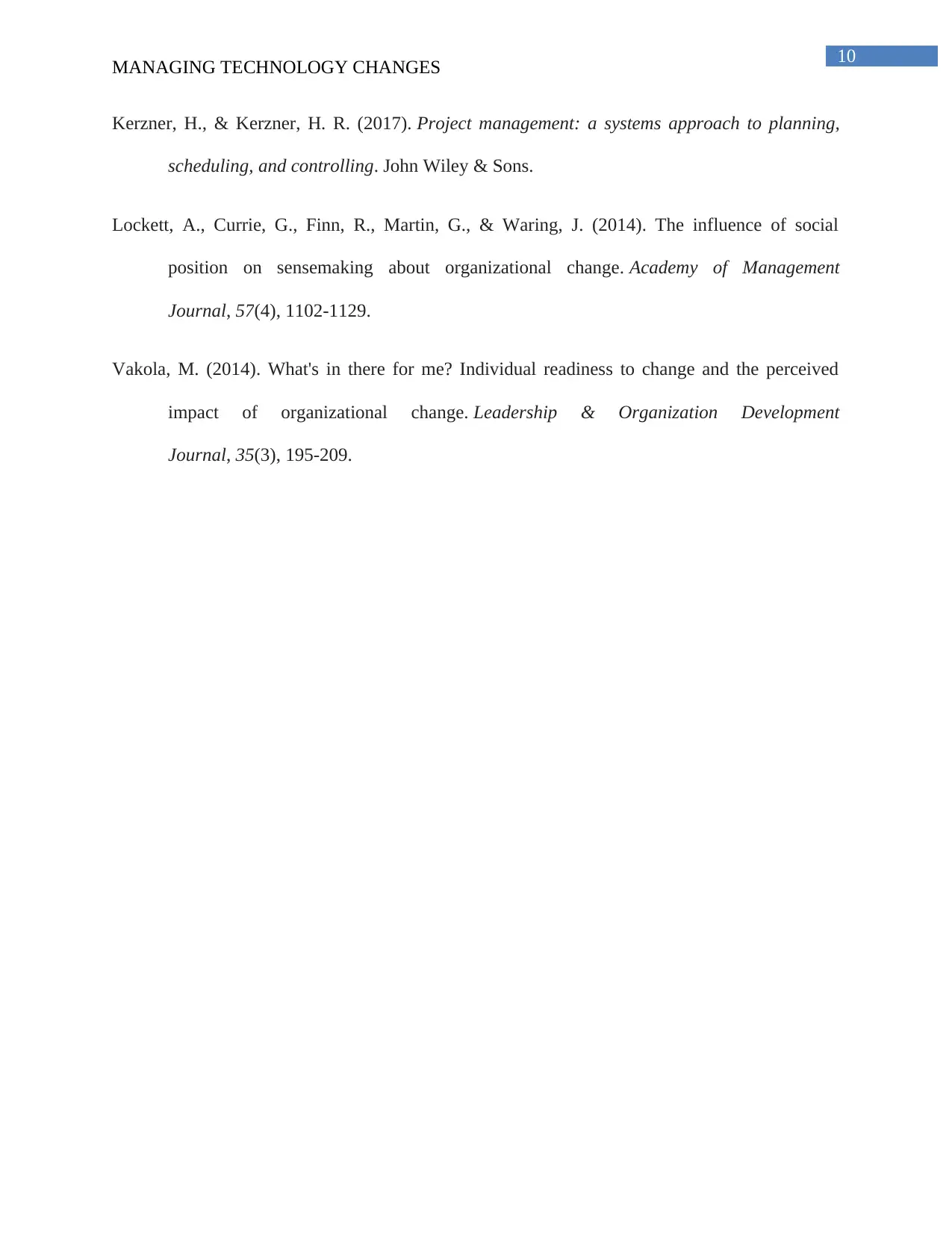
10
MANAGING TECHNOLOGY CHANGES
Kerzner, H., & Kerzner, H. R. (2017). Project management: a systems approach to planning,
scheduling, and controlling. John Wiley & Sons.
Lockett, A., Currie, G., Finn, R., Martin, G., & Waring, J. (2014). The influence of social
position on sensemaking about organizational change. Academy of Management
Journal, 57(4), 1102-1129.
Vakola, M. (2014). What's in there for me? Individual readiness to change and the perceived
impact of organizational change. Leadership & Organization Development
Journal, 35(3), 195-209.
MANAGING TECHNOLOGY CHANGES
Kerzner, H., & Kerzner, H. R. (2017). Project management: a systems approach to planning,
scheduling, and controlling. John Wiley & Sons.
Lockett, A., Currie, G., Finn, R., Martin, G., & Waring, J. (2014). The influence of social
position on sensemaking about organizational change. Academy of Management
Journal, 57(4), 1102-1129.
Vakola, M. (2014). What's in there for me? Individual readiness to change and the perceived
impact of organizational change. Leadership & Organization Development
Journal, 35(3), 195-209.
1 out of 11
Related Documents
Your All-in-One AI-Powered Toolkit for Academic Success.
+13062052269
info@desklib.com
Available 24*7 on WhatsApp / Email
![[object Object]](/_next/static/media/star-bottom.7253800d.svg)
Unlock your academic potential
Copyright © 2020–2025 A2Z Services. All Rights Reserved. Developed and managed by ZUCOL.




